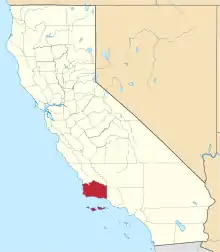Gaviota, California
Gaviota is an unincorporated community in Santa Barbara County, California located about 30 miles (48 km) west of Santa Barbara and 15 miles (24 km) south of Buellton.
Gaviota, California | |
|---|---|
 Gaviota aerial, including the oil installation and much of Gaviota State Park, 2009 | |
 Gaviota, California  Gaviota, California | |
| Coordinates: 34°28′18″N 120°12′50″W | |
| Country | United States |
| State | California |
| County | Santa Barbara |
| Elevation | 102 ft (31 m) |
| Time zone | UTC-8 (Pacific (PST)) |
| • Summer (DST) | UTC-7 (PDT) |
| Area code(s) | 805 & 820 |
| GNIS feature ID | 271285[1] |

Approximately 70 people live in Gaviota. The town is south and east of Gaviota State Park. The road to Hollister Ranch, the large private land holding along the coast between Gaviota and Point Conception, connects with U.S. 101 just west of Gaviota, at the turnoff to Gaviota State Park.[2][3][4]
Industries include organic farming, ranching, and woodworking. Free range cattle can be seen roaming and grazing throughout the area. Gaviota is also home to a marine mammal rehabilitation center named The Channel Islands Marine & Wildlife Institute (CIMWI.org) which opened in 2006 at the historic Vista Del Mar School grounds.[5]
Gaviota was once the location of the Gaviota Marine Terminal, which is currently being decommissioned and abandoned, with intent to become public open space.[6] On the mountain side of the freeway is the Gaviota Oil Heating Facility, also known as the "Gaviota Gas Plant", built by Chevron Corp. and currently owned by Plains Exploration & Production Company (PXP); this facility is being reconfigured and partially abandoned. The former purpose of the facility was to heat and process the heavy crude oil produced offshore so that it could flow through the All American Pipeline to refineries in the Bakersfield area.[6]
Gaviota Coast
The Gaviota Coast remains largely undeveloped and is the longest remaining rural coastline in southern California.[7][8] In 2016, the twenty-one miles of Highway 101 that runs through the Gaviota Coast, bounded by the City of Goleta’s western boundary and Las Cruces where Route 1, was declared a State Scenic Highway.[9][10][11] The preservation of this area is the subject of "The Twenty," a film by The Surfrider Foundation.
Gaviota tarweed, a rare and endangered subspecies (subsp. villosa) of Deinandra increscens[12] endemic to Santa Barbara County, is found here.[14]
History
The first European land exploration of Alta California, the Spanish Portolà expedition, camped at Gaviota Creek on August 24, 1769 (on its way north). On the return journey to San Diego, the party again stopped there on January 6, 1770. Franciscan missionary Juan Crespi noted in his diary, "I called this place San Luis Rey, and the soldiers know it as La Gaviota, because they killed a seagull there."[15] Gaviota is the Spanish word for "seagull".[16]
See also
| Wikimedia Commons has media related to Gaviota State Park. |
References
- "Yosemite Junction". Geographic Names Information System. United States Geological Survey.
- Kettmann, Matt (December 14, 2010). "Baron Ranch Calling All Hikers". Santa Barbara Independent. Retrieved 19 March 2017.
- Stewart, Ethan (February 14, 2013). "Illegal Pipes Removed". Santa Barbara Independent. Retrieved 19 March 2017.
- Stewart, Ethan (November 6, 2006). "Gaviota Goes to County Supes". Santa Barbara Independent. Retrieved 19 March 2017.
- Hayden, Tyler (July 11, 2011). "Hollisters Donate Last Piece of Land to Animal Rehab Center". Santa Barbara Independent.
- "Gaviota/Arguello Abandonment project". Energy Division. County of Santa Barbara Planning and Development. Retrieved 13 September 2016.
- "Final Gaviota Report". National Park Service. February 2004. Retrieved 19 March 2017.
- Martinez, Alys (May 27, 2017). "El Capitan Canyon reopens following heavy winter storm damage". KEYT. Retrieved 27 May 2017.
- "Announcing California's newest State Scenic Highway: Gaviota Coast State Scenic Highway". Scenic Highways. Caltrans. Archived from the original on 3 January 2017. Retrieved 3 January 2017.
- "Article 2.5 of Chapter 2 of Division 1". California Streets & Highways Code. Sacramento: California Office of Legislative Counsel. Retrieved February 6, 2019.
- Tallal, Jimy (October 20, 2017). "Topanga Canyon Boulevard Named State Scenic Highway". The Malibu Times. Retrieved 21 October 2017.
- USFWS. Final rule for endangered status for four plants from south central coastal California. Federal Register March 20, 2000.
- ssp. villosa. Jepson Manual
- Bolton, Herbert E. (1927). Fray Juan Crespi: Missionary Explorer on the Pacific Coast, 1769-1774. HathiTrust Digital Library. pp. 171–172. Retrieved April 2014. Check date values in:
|access-date=(help) - Gannett, Henry (1905). The Origin of Certain Place Names in the United States. Govt. Print. Off. pp. 135.
